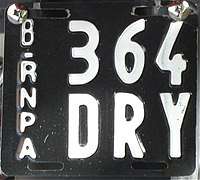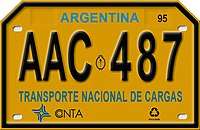Vehicle registration plates of Argentina
Argentine license plates (in Spanish, chapas patentes or simply patentes) are used to uniquely identify motor vehicles on the roads of Argentina. The current system employs three letters followed by three digits, issued consecutively, but the license plate system underwent significant changes before the use of this format.
-B.png)
The history of license plates in Argentina can be broken down in two major phases, the decentralized phase (until 1972) and the centralized one (since 1972). During the decentralized phase, license plates were assigned by each municipality or by the provinces, while during the second phase, the national state took charge of standardizing and centralizing the design and style.
1900s-1972: Decentralization
The first formal license plates were assigned in the 1900s, although few records exist of those. The period between 1916 and 1972 was the most prolific in designs. Since each district was allowed to issue its own license plates, it is possible to find a small piece of history of each one just by looking at their past plates.
1972-1994: Identifying the provinces

In 1972 the national government standardized the plates, the format being one letter and six digits, with embossed characters painted white against a black background. The letter identified the issuing province (or city, in the case of Buenos Aires), with the numbers issued consecutively in each jurisdiction. The letter usually was the first letter of the province's name, but for multiple provinces beginning with the same letters, some provinces were issued other letters (such as X for Córdoba, P for Formosa, A for Salta, Q for Neuquen and N for Misiones); this standard is still used in the ISO 3166-2:AR geocode.
The only two districts to ever surpass one million plates, thus generating a conflict in formatting, were the province of Buenos Aires and the capital, the city of Buenos Aires. The issue was resolved by halving the height of the letter and adding another number below it.
| Code | Subdivision name |
|---|---|
| C | |
| B | |
| K | |
| H | |
| U | |
| X | |
| W | |
| E | |
| P | |
| Y | |
| L | |
| F | |
| M | |
| N | |
| Q | |
| R | |
| A | |
| J | |
| D | |
| Z | |
| S | |
| G | |
| V | |
| T |
1995 onwards: A national standard

In 1994 the government decreed that all vehicles sold on or after January 1, 1995 were to have a new license plate design, used vehicles would get new plates upon re-sale after that date, and all other vehicles would be issued with new plates in stages.
The new design consists of three letters followed by three digits, and removes any clues identifying the vehicle's province of origin. This was advertised as a federalist move from the government.
In a move to simplify the transition, all plates issued to vehicles sold prior to the cut-off date started with the letter R (and successively S, T, U, V, W, and part of the X series), while vehicles being registered for the first time received plates in a series starting alphabetically with AAA 000. The lettering is impressed in white on a black background. The plates also have a white frame with the word Argentina at the top, screened in light blue. All materials are reflective, to improve visibility on the road. Some plates feature a small "D" or "T" between the letters and the numbers, denoting that this plate is a duplicate or triplicate when the previous plate or plates had been damaged, lost or stolen.
Limits of the system
The 3-letter-plus-3-digit code allows for 26³ × 10³ = 17,576,000 license plates. RAA-000 to ZZZ-999 were reserved for older vehicles. Since 1995, new licenses have been issued starting from AAA-000. In July 2005, new cars have licenses starting with F, while about the same month in 2004, license plates started with E. An efficient solution would be to add a fourth letter, which will increase the system's capacity by a factor of 26, to 456,976,000 vehicles (a fourth number would only increase it tenfold to 175,760,000 licenses). In August 2008, new cars had plates starting with HK. As of 2009, the series has reached the mid I series. In January 2015 the series had reached already the O series.
Evolution of lettering (starts January 1, 1995)
- Jan 1st, 1995 - AA-
- Jan 1st, 1996 - AP-
- Jan 1st, 1997 - BD-
- Jan 1st, 1998 - BV-
- Jan 1st, 1999 - CO-
- Jan 1st, 2000 - DC-
- Jan 1st, 2001 - DQ-
- Jan 1st, 2002 - DX-
- Jan 1st, 2003 - EC-
- Jan 1st, 2004 - EH-
- Jan 1st, 2005 - ET-
- Jan 1st, 2006 - FI-
- Jan 1st, 2007 - GA-
- Jan 1st, 2008 - GV-
- Jan 1st, 2009 - HU-
- Jan 1st, 2010 - IN-
- Jan 1st, 2011 - JN-
- Jan 1st, 2012 - KU-
- Jan 1st, 2013 - LZ-
- Jan 1st, 2014 - NM-
- Jan 1st, 2015 - ON-
- Jan 1st, 2016 - PM-
According to first letter start:
- A - JAN 1995
- B - OCT 1996
- C - MAR 1998
- D - NOV 1999
- E - MAY 2002
- F - JUN 2005
- G - DEC 2006
- H - FEB 2008
- I - APR 2009
- J - JUL 2010
- K - MAY 2011
- L - FEB 2012
- M - JAN 2013
- N - AUG 2013
- O - JUL 2014
- P - JUL 2015
From 2016: Mercosur standard
In October 2014 the design of the new license plate to be used by all Mercosur countries was officially presented. It consists of a plate of 400 mm × 130 mm (15.75 in × 5.12 in), with a white background, the characters and frame in black and a blue band at the top that shows the name of the country, its flag and the Mercosur logo. The typeface used is FE-Schrift. In Argentina, the serial format is AA 000 AA, allowing a total of 450 million combinations. The system started with AA 000 AA, AA 000 AB ... AA 000 AZ, AA 000 BA... AA 000 ZZ, AA 001 AA... By January 2017, there were plates with license numbers as high as AA 950 AA. It is expected the AB series to start in February 2017. Series AC started in December 2017, while AD started in November 2018. As of April 2019, the highest number is AD530.
Other types
| Image | Type | Serial format | Design |
|---|---|---|---|
 |
Diplomatic Corps | CD 1234 or CD-1234 | black on white; longer plate size; variety of manufacturing styles |
 |
D123xxA | ||
 |
Consular corps | CC-1234 | orange on teal; "Rep. Argentina" legend; longer plate size |
 |
C123xxA | ||
 |
Special missions | ME-1234 | orange on teal; "Rep. Argentina" legend; longer plate size |
 |
M123xxA | ||
 |
International organization | OI-1234 | orange on teal; "Rep. Argentina" legend; longer plate size |
 |
I123xxA | ||
 |
Non-diplomatic embassy staff (personal auxiliar) | PA-1234 | orange on teal; "Rep. Argentina" legend; longer plate size |
 |
A123xxA | ||
 |
Motorcycle | 123/ABC | Until 2010. White on black; vertically at left is one-letter province code over a horizontal line over "RNPA". |
 |
123 ABC | Starting in 2010. | |
 |
Registro Nacional de la Patente Automotor | ABC 12 | white on black; "RNPA" and "Republica Argentina" legends |
 |
Temporary | RAB-1234 possibly UAB-1234 |
red on white; made of paper |
 |
Trailer | 101 ABC 123; alpha-numeric sequence matches that of primary mover | same design as standard plate but with narrower serial characters |
 |
Transporte Nacional de Cargas | ABC 123 | teal on yellow; more square plate |
Sources
- clarin.com - Las claves de las nuevas patentes para vehículos del Mercosur
- dnrpa.gov.ar - Patente Unica del Mercosur